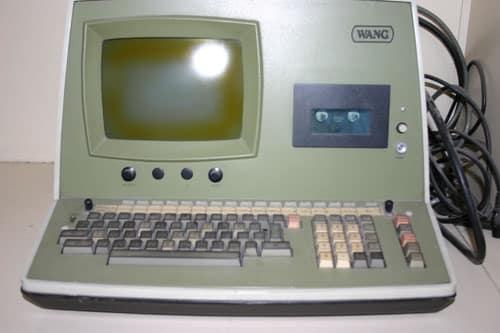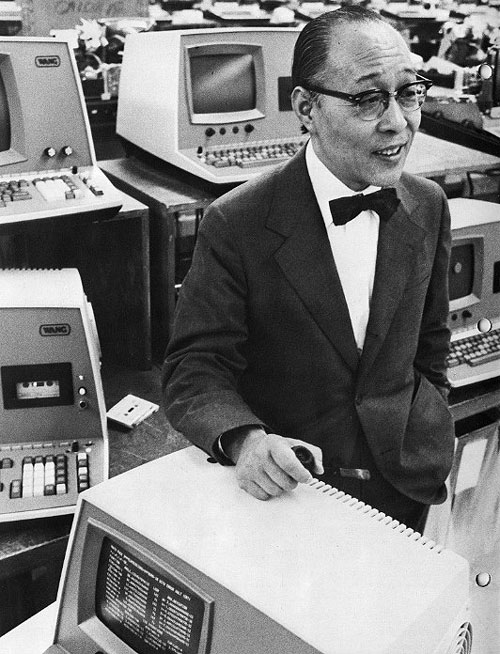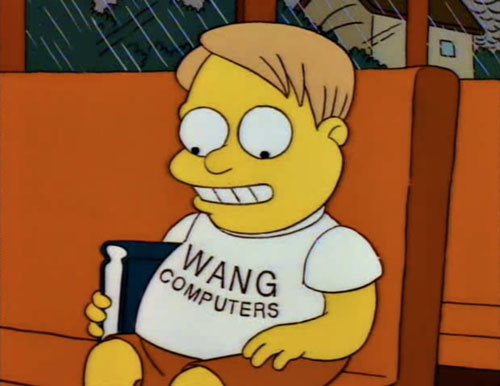We’re Gunning For IBM
The minicomputer maker Wang Laboratories ran an ad on the Super Bowl long before Apple did. So why did the company and its minicomputers become a footnote?
Editor’s note: This has been a very big week on the Tedium front; Monday was our website’s most successful day ever, with more than 10,000 visitors, and we were also featured on NPR’s Planet Money with a whole lot of other cool things. As a result, we have a whole lot of new subscribers this time around—we just topped the 5,000 mark, in fact. We love you all equally.
“Failure is inevitable and provides valuable feedback that can move you in the right direction. You have to risk failure to succeed. The important thing is not to make one single mistake that will jeopardize the future.”
— A quote, attributed to Wang Laboratories cofounder An Wang, about the nature of failure. For much of his career, he knew little about failure. Born in Shanghai in 1920, Wang took advantage of a World War II-era program that allowed him to take part in a training program in the United States. This led him to Harvard as a graduate student—and with the war still going on, he was able to get in without too much trouble. While on the Harvard campus, he filed a patent for magnetic core memory, an early form of RAM that proved a fundamental building block for the computing industry. He later sold that patent to IBM for an estimated $500,000—an amount that allowed him to build a company that would later compete with IBM.

The Wang 2200. (via Wikimedia Commons)
The product (and strategy) that turned Wang computers into a household name
Wang Laboratories went through an array of different evolutions throughout its life, but the one that truly stuck—and defined it in the 1970s—was its line of minicomputers.
These devices, aimed at offices, were smaller in size than the mainframes of the era, but predated the microprocessors that you know and love today, so they were still pretty big. Sold to resellers who customized the computers for purpose-built reasons, different kinds of Wang devices were used for services such as word processing and data management. Still, the design of the actual terminals themselves should look pretty familiar to computer users familiar with the PCs of the early 1980s.
“In some respects, it was similar to microcomputers that came four or five years later, such as the Commodore Pet or the TRS-80,” the Wang2200.org website states. “Of course, the 2200 was much more rugged, reliable, and expandable than such machines.”
Part of its marketing approach was specifically to needle IBM, whom Dr. Wang harbored ill feelings toward because of his treatment at the hands of the tech giant when selling his patent. (It was so serious that Wang initially avoided the PC clone business because its owner didn’t want to give IBM the satisfaction.)
Their strategy was tough. These days, you can target the enterprise pretty narrowly through niche channels, but back then, if you wanted to advertise on TV, you had to go big.
And in 1978, if you wanted to draw some eyeballs, you advertised before the Super Bowl. That’s right, six full years before Apple made its infamous “1984” ad, Wang made a commercial with a similar conceit—that IBM was a dangerous giant that needed to be taken on by a “David” of the world.
And if you think that’s not subtle enough, you should see what they did for the 1985 Super Bowl. Tagline? “Wang: We’re Gunning for IBM.”
In The Advertising Age Encyclopedia of Advertising, the 1978 saga is described as an attempt to boost name recognition among corporate managers. Before the commercial, Wang had brand awareness of 4 percent among the managers it was trying to reach. Within six months of the ad, the number was up to 80 percent.
Wang sold itself as an enterprise solution, and advertised its email platform this way as far back as 1980. The firm grew really big, really fast. Problem was, the market was moving away from minicomputers to computers with microprocessors. And that exposed challenges within the company.
14
The number of products that Wang Laboratories announced in a single day in October 1983—most notably a computer that could scan, store, and deliver paper documents throughout the office using a digital imaging system. Most of the products announced, however, did not ship for various reasons, in part because they weren’t ready—making the event an astonishing show of vaporware.

Dr. An Wang, shown with an array of 2200 models. (Via the Computer History Museum)
Wang Laboratories’ fatal flaw: Its founder thought it was a family business, until it was too late
The problem with technology companies is that they often make really bad family businesses, especially in the West. For every story like Casio, there are plenty of others where the nepotism approach has a negative effect on a company’s future.
An Wang saw his namesake company as a family business, one in which his son Fred could take over and ensure its legacy.
The focus on family led Dr. Wang to take dramatic steps to hold onto control. The company’s stock structure, as laid out by a 1986 New York Times article, highlights this. The public traded the company’s class B stock, which paid dividends, but the Wang family controlled class C stock, which kept company ownership consolidated.
“All other things being equal, my children should be more highly motivated than a professional manager because of their substantial stake in the ownership of the company,” the elder Wang wrote in his book, Lessons.
But Fred, who hopped into the role as Wang was suffering from a slump, proved a not-so-great fit. There were already warning signs: He had been installed as the head of research and development at the time of the company’s embarrassing vaporware announcement.
A 1992 Computerworld piece about Wang Laboratories’ demise pinned the problem on a strong desire to build a company with a family lineage. And when An Wang made Fred president in November 1986, the report noted that many people within the company had concerns:
For years, there have been quiet concern about Fred. Members of the board of directors had worried that Fred did not have the experience, the judgment—the overall heft—to lead the company. Ever since the middle of the 1980s, outside directors had made repeated efforts to persuade the Doctor to bring in a professional manager—to give Fred an impressive title if needed but to avoid placing the young man in operational control of this sprawling, worldwide corporation in the thick of the most competitive industry on earth.
An Wang would not yield. To the directors he said: “He is my son. He can do it.”
When Fred became president—replacing someone with nearly 20 years of experience, John F. Cunningham—he quickly failed to live up to the high expectations set by his father. Within two years, Fred presided over a change in fortunes so significant that a company that once had shares that topped the $800 mark had lost $424 million in a single fiscal year—the equivalent of $936 million today.
(Charles Kenney, the author of the ComputerWorld article, did not lay the failure at Fred’s feet, but his father’s, saying his father leaned too hard on family considering the sophistication of the company.)
Dr. Wang would not get his wish of a family legacy. In poor health, just weeks after a surgery to remove a cancerous tumor from his throat, he found himself in the unenviable position of firing his son.
The elder Wang, who died less than a year later, departed as his company was struggling to stay afloat—under a new set of leaders, who laid off thousands of the company’s employees.
In 1992, the company filed for chapter 11 bankruptcy.
It could be said that the leadership challenges that Wang Laboratories faced came about largely as a side effect of the shifting waves in computing. It’s easier to make an unforced error when you’re not keeping up with trends.

Because no story about Wang computers is complete without this image of Martin Prince.
If you were to compare An Wang to Steve Jobs, as I’m sure some folks are annoyed that I’m doing, you’d find two folks with definitive visions of technology that bled through their given organizations. Additionally, both were defined in part by their competitors—Apple with Microsoft, Wang with IBM.
But Apple survived Jobs’ departure and demise because it had a steady stream of innovation going on every year. Wang was still producing minicomputers almost until the day it filed for bankruptcy. (Minicomputers were a bad business to be in around 1992.) It struggled to find the next step, and culturally it never did rediscover its footing after An Wang tried to take a step back. He was too important to the company for it to thrive without him.
Wang’s book Lessons, which came out in the midst of his company’s decline, focused mostly on his own formidable history, rather than his company’s struggles. Probably for the best—he deserves to be seen for his innovation, not just his weak spots.
In 2013, USA Today writer Mark Veverka, gave Wang Laboratories the kind of indignity most folks wouldn’t wish on their worst enemy: In highlighting the modern computing landscape, he compared Wang to Dell.
Wang wasn’t Dell—its ads were way better, its leader a stronger visionary—but there’s a pretty good lesson about culture in the tale of Wang Laboratories.
:format(jpeg)/2017/02/tedium021417.gif)
/2017/02/tedium021417.gif)

/uploads/ernie_crop.jpg)